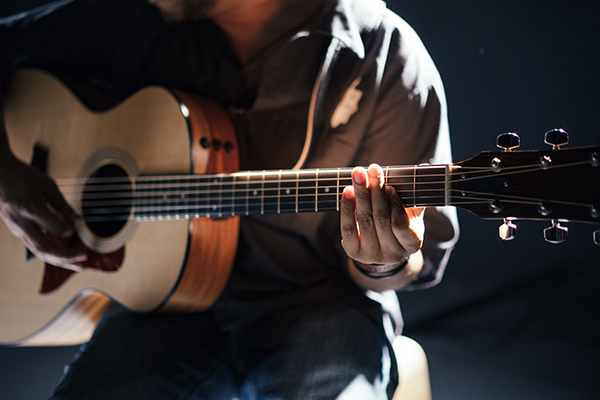The piece is a Mozart sonata music style which will be presented in A major. The instrumentation of the music includes violin and piano. The whole piece will be divided into three parts with three different expression methods, and it will use the four-two rhythm. In the first part, the composition will be played in Adagio tempo that could express a graceful and peaceful feeling. When people listen to Mozart’s music, they can always feel bright, vivid and fluid. One of the reasons is that his music contains many eighth and sixteenth notes. Therefore, to keep the Mozart style feeling, the music will also utilize the eighth notes as upbeat in the beginning.
An upbeat beginning is very helpful to make the following melody sounds fluid and brisk, it also feels like taking a deep breath before you talk. The violin and the piano will play the short F sharp note together to creates the beginning of the musical dialogue. Mozart’s music has a strong dialogism. Then in the second bar, the violin begins to play the main melody of the whole piece. At the same time, the piano part starts to perform some repetitive rhythm and notes as the response to the violin part. Then after the violin expresses the “idea” of the music, the piano could express its own “different opinion”. To compose the “argument” part, the violin and the piano could play in the same rhythmic pattern, but the melody could be more dramatic contrast. While the violin could play the G sharp note in a high position on E string, the piano can play the lower G sharp note to produce an octave. With the different timbre of the violin and piano, the comparison will be clearer. Then a quarter note appears that make the “argument” ends.
Mozart always uses repetitive structure to complete the role exchange between the instruments. His music does not only sound like a piece of symphony or concerto, but it also sounds more like a piece of opera, so after violin play as a narrator and the piano play as the listener, the two instruments switch their roles. In the following bars, the violin will play the former piano melody and the piano starts to become the narrator that presents the main melody. The structure is similar to the former dialogue. In the end, the violin will play an A and the piano could play several groups eighth notes that lead the phrase to the end.
The second part will be more different from the first part. The second part is more like the most intense part of a conversation. There will be more conflicts between the violin melody and the piano melody. The conversation will not be peaceful in this part and the tempo changes to the Allegro. In the beginning, the dotted notes will appear. The continuous dotted notes seem to indicate the coming conflicts of the two parts. Also, in the second part, some disharmonious intervals can be added into the melody. For example, the minor second like F sharp and G natural, C sharp and D natural will appear in the second part melody to make a different feeling.
The violin part will start with a quarter note and then there will be several groups of sixteenth notes after the quarter note ends. The second part could also utilize a short chromatic scale to lead the melody to the climax of the whole piece. The melody of the piano part will be peaceful in the beginning, but with the sixteenth notes starts and the chromatic scale goes on, the piano part will change to be more passionate and intense. The melody becomes more dynamic because of the change of the tempo. Then the piano and the violin continue to exchange their role. The piano repeats the melody of the violin and the violin becomes more peaceful compared to the former part. Then the two parts play the same melody together to solve the whole conflicts.
The third part will be similar to the first part. The tempo changes to Adagio again. The melody expresses a peaceful conversation again. But in the third part, the phrase should create an ending feeling to complete the whole conversation. In the end, instead of creating some small conflicts in the dialogue, more descending melody scale should be used to help the whole movement end. The eighth notes need to reduce and more quarter notes will be added. In Mozart’s sonata, the basic aesthetic of his music style is to create dramatic tension and resolve it. Therefore, at the end of the third part, all the melodic conflicts need to be resolved, and the final note will be composed to end in the A major.

